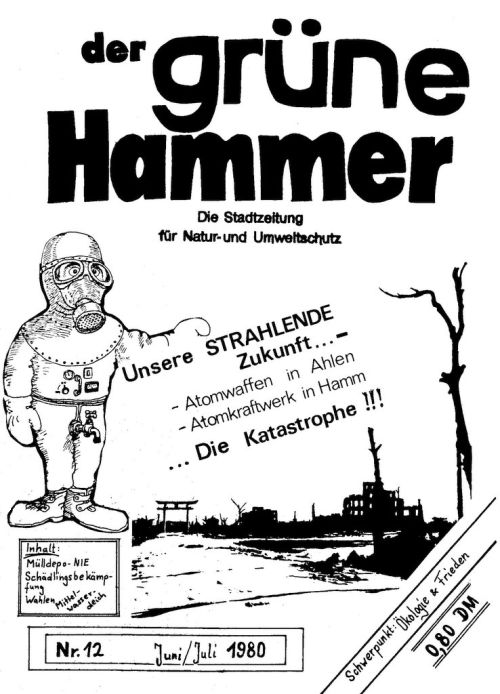Newsletter IX 2021 | |
February 25th to March 02th
***
| 2024 | 2023 | 2022 | 2021 | |
| 2020 | 2019 | 2018 | 2017 | 2016 |
| 2015 | 2014 | 2013 | 2012 | 2011 |
| Current news+ | Background knowledge |
***
Renewable energies should be promoted more
March 02, 2021 - Former Japanese prime ministers call for Japan's phase-out of nuclear energy
*
March 01, 2021 - Asse interim storage facility brings additional radioactive contamination
*
March 01, 2021 - Macron relies on nuclear power
*
March 01, 2021 - Nuclear power plant in Eemshaven: Prime Minister Rutte heats up the discussion again
*
March 01, 2021 - Hydrogen Alliance welcomes Federal Network Agency's decision against large-scale electrolysis projects
*
February 28, 2021 - Hydrogen as an alternative: The shortest joke
*
February 28, 2021 - Green light for electricity from the North Sea to Hamm
*
February 28, 2021 - Nuclear climate protection
*
February 27, 2021 - "For Europe, this could mean extreme heat waves"
*
February 27, 2021 - Gorbachev's appeal to Putin and Biden - "The main thing is to prevent nuclear war"
*
February 26, 2021 - 10 years of Fukushima: Promote independent research instead of preventing it
*
February 26, 2021 - Nuclear factory: French-Russian joint venture
*
Term extension to 50 years
February 25, 2021 - France is holding on to old nuclear power plants
*
February 25, 2021 - US military spending leads the way
*
February 25, 2021 - Gulf Stream system weakening 'unprecedented'
*
February 25, 2021 - Too prone to failure and unreliable: For the DIW, nuclear power has no future
*
February 25, 2021 - France: Nuclear regulator approves lifetime extension
Top | |
| Current news+ | Background knowledge |
***
Current news+
**
Flash flood in the Himalayas
February 25, 2021 - One and a half kilos of plutonium lie on the Nanda Devi
In 1965, the CIA lost a nuclear battery in the high mountains. Local politicians are calling for the device to be recovered
Shortly after noon on February 7, a 550-meter-wide chunk of the glacier on Mount Ronti (6.063 meters) in the northern Indian state of Uttarakhand erupted. The ice masses triggered a flash flood in the Rishiganga River, which damaged two power stations and killed 231 people.
Natural disasters such as the "Himalayatsunami" in 2013, in which 5.700 people died, usually occur when the snow melts. The fact that this happened in the middle of winter led the Indian media to speculate that the glacial collapse could have been caused by a US spy facility lost in the high mountains 55 years ago...
Top | |
| Current news+ | Background knowledge |
***
Background knowledge
**
reaktorpleite.de
Map of the nuclear world:
1,5 kilos of plutonium on the roof of the world ...
The German version of this world map:
https://www.google.com/maps/d/viewer?mid=1fCmKdqlqSCNPo3We1TWZexPjgNDQOaLD
**
The search in the reaktorpleite.de with the search term
| Plutonium | ||
brought the following results, among others:
July 17, 2020 - Europe: Map shows radioactive soil pollution
*
SMR - the nuclear reactor for the front yard!
May 03. 2018 - NASA successfully tests Kilopower reactor
world-nuclear-news.org - Translate with https://www.deepL.com/translator (free version)
**
YouTube channel "Reaktorpleite"
 US President Dwight D. Eisenhower: Warning of the military-industrial complex (Deep State)
US President Dwight D. Eisenhower: Warning of the military-industrial complex (Deep State)
**
AtomkraftwerkePlag
Plutonium batteries and radioactive contamination
For decades, so-called radionuclide batteries have been used in space travel to generate electricity, which generate energy from radioactive decay; the English term for it is Radioisotope Thermoelectric Generators (RTGs). Plutonium or americium are mostly used in RTGs. In addition, so-called radioisotope heater units (RHUs) have been developed to generate heat for the instruments.
The US first used an RTG in 1961 on the Transit 4A navigation satellite, and another in 1969 on the Nimbus III weather satellite. RTGs and partly RHUs were used in the missions Apollo, Pioneer, Viking, Voyager, Galileo, Ulysses, Cassini and New Horizons. The Mars rovers Pathfinder, Spirit and Opportunity used solar energy, but generated the heat for the instruments with RHUs. During the Curiosity mission from 2011, the multi-mission radioisotope thermoelectric generator was used for the first time to generate electricity and heat. Since the 1960s, the Soviet Union and later Russia also used radionuclide batteries in space travel.
The use of radioactive batteries has led to serious accidents several times:
In 1964, a US Navy satellite crashed on launch, distributing one kilogram of plutonium into the atmosphere.
In 1978 the reactor core of the Soviet satellite "Kosmos 954" contaminated 124.000 square kilometers in Canada after a crash landing.
In 1996 the Russian Mars-96 probe crashed with 200 grams of plutonium into the border area between Chile and Bolivia ...
**
Wikipedia
Radionuclide batteries for space travel
A sufficiently large, compactly arranged amount of 238Pu heats up to white heat due to its own radioactive decay and emits only very small amounts of gamma radiation, so that one gets by with the thinnest shielding compared to five other potentially suitable nuclides. It is therefore used in oxidized form as chemically inert plutonium dioxide to generate electrical energy in radionuclide batteries.
Because of their longevity, radionuclide batteries are used in interplanetary space travel, especially for space probes that are supposed to reach the outer solar system. Because solar cells no longer supply enough energy at a great distance from the sun. Such nuclear batteries were built into the Voyager probes, Cassini-Huygens (1997–2005 for Saturn) or New Horizons (2006–2015 for Pluto), for example. In the past, radionuclide batteries with plutonium 238Pu were also used in orbiting satellites.
In 1964, the US Transit 5BN-3 satellite with a radionuclide battery on board burned up in a false start about 50 kilometers above the Pacific. The satellite contained almost one kilogram of plutonium, which was then measurably distributed over the entire northern hemisphere ...
*
MiK - Military-Industrial Complex
The term military-industrial complex (MIK) is used in socio-critical analyzes to describe the close cooperation and mutual relationships between politicians, representatives of the military and representatives of the armaments industry. In the US, think tanks such as PNAC are seen as a possible additional stakeholder group.
Coining of the term
The concept of a military-industrial complex was coined in 1956 by the American sociologist Charles Wright Mills under the title The Power Elite (German: "The American Elite: Society and Power in the United States"). Mills shows the close interests between the military, business and political elites in America after the Second World War. The 9th chapter "The Military Ascendancy" is particularly relevant. Mills does not use the term “military-industrial complex”. He speaks of the "military establishment". Mills saw it as a serious threat to the democratic state structure and a risk for military clashes between the United States and the Soviet Union. In criticizing the military's influence on science and research, Mills cites as an example that Eisenhower, as ex-general, was director of the University of Columbia. Eisenhower, of all people, later took up Mills' criticism and coined the term military-industrial complex ...
**
Further to: Newspaper article 2021
***
Top | |
| Current news+ | Background knowledge |
***
Donation appeal
- The THTR circular is published by the 'BI Environmental Protection Hamm' and is financed by donations.
- The THTR circular has meanwhile become a much-noticed information medium. However, there are ongoing costs due to the expansion of the website and the printing of additional information sheets.
- The THTR circular researches and reports in detail. In order for us to be able to do that, we depend on donations. We are happy about every donation!
Donations account:
BI Umweltschutz Hamm
Purpose: THTR circular
IBAN: DE31 4105 0095 0000 0394 79
BIC: WELADED1HAM
***
***



